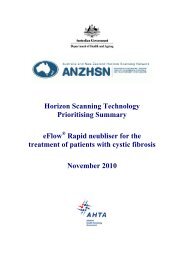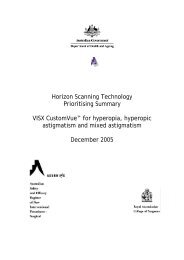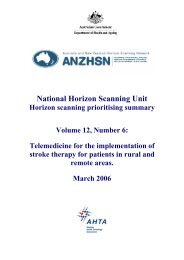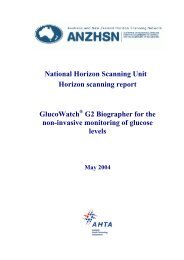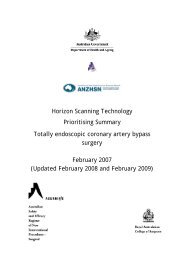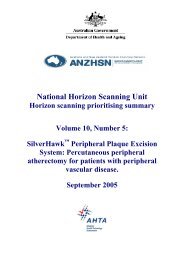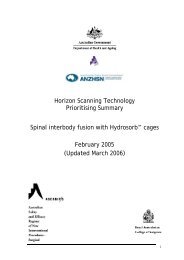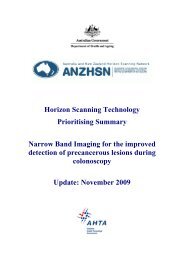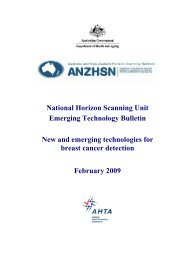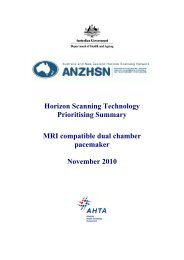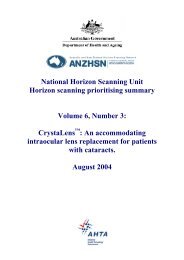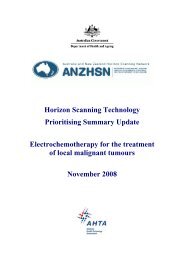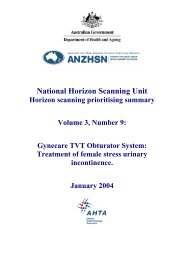Totally endoscopic coronary artery bypass surgery (Update)
Totally endoscopic coronary artery bypass surgery (Update)
Totally endoscopic coronary artery bypass surgery (Update)
Create successful ePaper yourself
Turn your PDF publications into a flip-book with our unique Google optimized e-Paper software.
statistically significant changes in the left ventricular ejection fraction as a result of the<strong>surgery</strong> (Schachner et al. 2007).In a study conducted by Bonatti et al. (2007) 10 patients (mean age 59 years), presentingwith either left main disease or left main equivalents, underwent totally <strong>endoscopic</strong>double-vessel <strong>coronary</strong> <strong>artery</strong> <strong>bypass</strong> grafting using the da Vinci system, remote-accessperfusion and aortic balloon endo-occulsion. In each patient <strong>endoscopic</strong> placement ofright IMA to the LAD in conjunction with left IMA grafting to an obtuse marginal (OM)branch was performed by a single surgeon. This procedure was successful in sevenpatients (70%). Three conversions to open CABG (via stermotomy) were required as aresult of intraoperative complications and to prevent major vascular injury. Thesecomplications included injury to the LIMA to OM graft by an <strong>endoscopic</strong> instrument aftersuccessful completion of <strong>bypass</strong> conduit, OM graft revision due to anastomotic stenosison the intraoperative angiographic control and an iliac <strong>artery</strong> level blockage of the RAPcannula advancement. There were no patient fatalities reported. Median ventilation timewas 15 hours, median ICU stay was 41 hours and median patient discharge time wasseven days post-op. The follow-up period ranged from one month to two years (medianfour months). During this time eight patients (80%) experienced no postoperativesymptoms. However, two patients reported chest pain not associated with myocardialischemia on stress tests. Other than these minor side effects, no major adverse cardiac orcerebrovascular episodes were observed throughout the entire observation period in anypatients (Bonatti et al. 2007).2008 HealthPACT ActionThe evidence regarding TECAB remains limited. Comparative clinical trials are requiredto compare TECAB with conventional CABG. These studies should ideally incorporatelonger follow up periods, the effect of surgeon experience on TECAB outcomes and theeffect of increased operation times on postoperative outcomes. Despite this, TECABappears to offer a potentially safer and less invasive alternative to CABG.This technology will therefore be monitored for 12 months.Number of Studies IncludedTotal number of studies 4Level III-2 intervention evidence 1Level IV intervention evidence 3ReferencesBonatti J, Schachner T, Bonaros N, Ohlinger A, Rutzler E, Feuchtner G, Kolbitsch C,Friedrich G, Bartel T,Pachingero and Laufer G. Robotic totally <strong>endoscopic</strong> double-vessel<strong>bypass</strong> grafting: A further step toward closed-chest surgical treatment of multivessel<strong>coronary</strong> <strong>artery</strong> disease. Heart Surgery Forum 2007; 10 (3): E239-E242.de Cannière D, Wimmer-Greinecker G, Cichon R, Gulielmos V, Van Praet F, Seshadri-Kreaden U and Falk V. Feasibility, safety, and efficacy of totally <strong>endoscopic</strong> <strong>coronary</strong><strong>artery</strong> <strong>bypass</strong> grafting: Multicenter European experience. Journal of Thoracic andCardiovascular Surgery 2007; 134 (3): 710-716.



